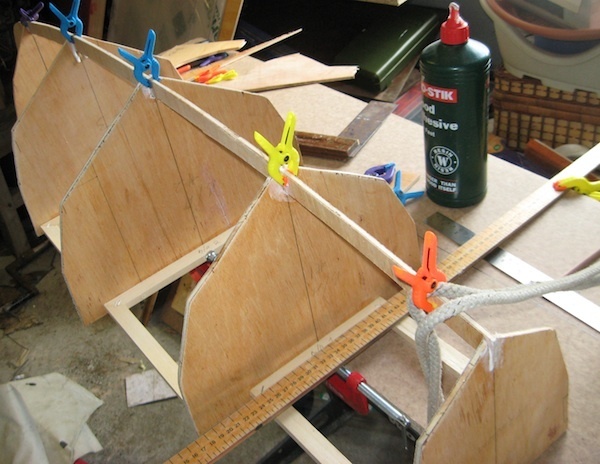The keel is attached.
by Dermot Tynan in Microtransat
Posted on Saturday, April 20, 2013 at 08:00
After much sanding and polishing of the keelson, and the frames for the hatches and top deck, the hull is starting to take shape.
The bulkheads are cut from 6mm exterior grade plywood. The wood which resembles a picture frame is pine, and it is used to hold the bulkheads and transom into a square position, and to provide additional strength to the hull. Eventually those frames will be covered over by 6mm ply on the deck.
The original plan was to stretch 6mm ply across the bulkheads, to form the hull. However, the ply doesn't bend too easily, and it seemed easier to use a sandwich construction instead.
A sandwich construction is used in a lot of fibreglass sailboats. It comprises two layers of fibreglass either side of a soft wood, such as balsa.
In this example, the thin strips of balsa will be glued or stapled to the bulkheads, to provide a thin (and not particularly strong) wooden hull. The next step after sanding the hull smooth, will be to paint the hull with polyester resin and three or four layers of chopped strand matt (fibreglass). After the final CSM layer, the hull will again be sanded and polished. Finally, a thick layer of epoxy resin will be applied as an outer coat (thanks to Henry for pointing out that you can't paint gelcoat onto the outside of the hull!).
Inside the hull, the same treatment takes place, with two or three layers of CSM onto the exposed balsa wood. I won't add fibreglass to the ply as it is strong enough. Although all of the bulkheads (and the transom) will have a thick coat of epoxy applied.
You can just make out the curvature of the bow, just forward of the fourth bulkhead (the nearest ply section in the lower right of the picture is the transom). It is sharper than it looks in the image, which portrays it as quite a rounded bow.
The first compartment (between the transom and bulkhead #1) will be filled with closed-cell polyurethane foam. For anyone making a similar boat, make sure your PU foam is closed cell or it'll soak up water like a sponge. If in doubt, test a small amount, submerged in water overnight. It should weigh the same after 24 hours of submersion as it did before it went into the water.
Compartments 2 and 3 will house the electronics and control systems. Compartments 4 and 5 will also be foam-filled right up to the bow.
Compartment #5 will have a deck strengthener added as I intend putting a small cleat on the bow. The mast will probably be mounted on top of bulkhead #3.
Finally, the keel will be affixed to the underside of the hull between bulkheads #2 and #3, which means I need to add some strengtheners to the keelson, approximately between the two blue clamps in the picture.
So, after much discussion and debate, and many hours poring over DelftSHIP, the hull is starting to come together.
Thanks to Henry Lupton for the decision to use 6mm ply with hard chines.
Search
Upcoming Missions
- Galway Bay Loop, Waiting for Vessel Availability
Recent Posts
- May 2023 (1 post)
- April 2023 (1 post)
- March 2023 (1 post)
- February 2023 (2 posts)
- March 2022 (3 posts)
- March 2021 (1 post)
- August 2020 (1 post)
- May 2019 (1 post)
- April 2018 (1 post)
- November 2017 (1 post)
- April 2017 (1 post)
- November 2016 (1 post)
- September 2016 (1 post)
- August 2016 (1 post)
- January 2014 (2 posts)
- October 2013 (7 posts)
- September 2013 (1 post)
- August 2013 (3 posts)
- June 2013 (3 posts)
- May 2013 (4 posts)
- April 2013 (3 posts)
- March 2013 (9 posts)
- February 2013 (8 posts)
